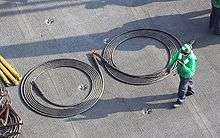Non-skid
Non-skid is a surface applied to the deck of a ship to increase the coefficient of friction and reduce the probability of footwear or vehicle tires sliding along a smooth wet surface.[1] When decks are painted for protection against wear and corrosion, non-skid may be formed by either mixing a granular material like sand into the paint prior to application, or by sprinkling dry sand onto a newly painted surface before the paint hardens by drying or curing.[2]
Examples
_returns_to_the_General_Dynamics_Electric_Boat_shipyard.jpg) The portion of this submarine hull intended to be walked upon has been covered by non-skid identifiable by darker color.
The portion of this submarine hull intended to be walked upon has been covered by non-skid identifiable by darker color. Flight decks are entirely covered by non-skid to prevent aircraft from sliding overboard as the ship rolls.
Flight decks are entirely covered by non-skid to prevent aircraft from sliding overboard as the ship rolls. The texture of this flight deck non-skid reveals the application strokes used to spread the mixture of paint and sand.
The texture of this flight deck non-skid reveals the application strokes used to spread the mixture of paint and sand.
Sources
- Brannin, Patricia A. "Non-Skid Materials Used on Navy Ships" (PDF). United States Department of Defense. Retrieved 20 March 2020.
- "How do you paint non-skid decks?". International. AkzoNobel. Retrieved 20 March 2020.
gollark: Also, I'm not entirely sure it's a good idea to stack-allocate a 520-byte array.
gollark: I should have gone for 5 dimensions for the fancier-sounding name. Oh well.
gollark: I don't think it can ever be actively *harmful* to capture a square, just not optimal.
gollark: That's probably a sensible heuristic.
gollark: I think so.
This article is issued from Wikipedia. The text is licensed under Creative Commons - Attribution - Sharealike. Additional terms may apply for the media files.